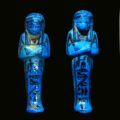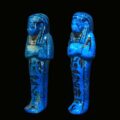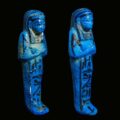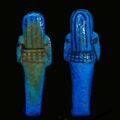Two Shabtis of the Chief of the Harem Tayu-heret
Culture: Egyptian
Period: 3rd Intermediate period, 21st dynasty, 1069-945 B.C.
Material: Faience
Dimensions: 10.6 cm and 10.8 cm high respectively
Price: 18 000 Euro
Ref: 1488
Provenance: Found 1881 in the cachette of Deir el-Bahari. Thence in the collection of the archaeologist Emil Brugsch (1842-1930), who played a key role in recovering the finds. Later with Christie’s Tokyo on 11 February 1980, lots 655 and 656. Last in the Dr. W. Benson Harer family collection. With a copy of the collection note.
Condition: Intact
Description: Two finely worked out shabtis of blue glazed faience, which belonged to Tayu-heret and were found in 1881 in the famous cache at Deir el Bahri (“Royal Cache”). Tayu-heret was the wife of the Amun high priest Masaharta, one of the sons of the King of Upper Egypt Pinedjem I. She held the title “Chief of the harem of Amen-Re”. Today around 60 shabtis of Tayuheret are known, which are in museums and private collections. The present two examples originally belonged to the collection of the German archaeologist Emil Brugsch (1842-1930), who was significantly involved in the recovery of the mummies and art treasures from the cache at Deir el-Bahar. The shabtis are in mummiform with the arms crossed in front of the chests, each one holding a hoe. They wear tripartite wigs with horizontal stripes on the calotte and vertical ones on the lobes. Eyes, brows, collar and the seed bag on the back are painted in black, mouth and nose are protruding. The hieroglyphs run vertically along the front of the legs and mention the names of the owner. The translation reads: “May Osiris enlighten Tayu-heret.” For a standard work to the shabtis of Tayu-heret see Niek de Haan and Patrice Renaut “The workers shabtis of Tayu-heret”, First Edition 2022, published on shabticollections.com. At least 14 shabtis of Tayuheret are in the Egyptian Museum in Cairo, further ones in the Louvre (inventory number E 7677, E 20325), in the British Museum (inventory number 35371), and in the Kunsthistorisches Museum in Vienna (inventory number INV 6060), as well as in numerous other important museums in the USA and Europe. On an old wood base. One shabti with an old inventory number 36.3.31 at the back.







